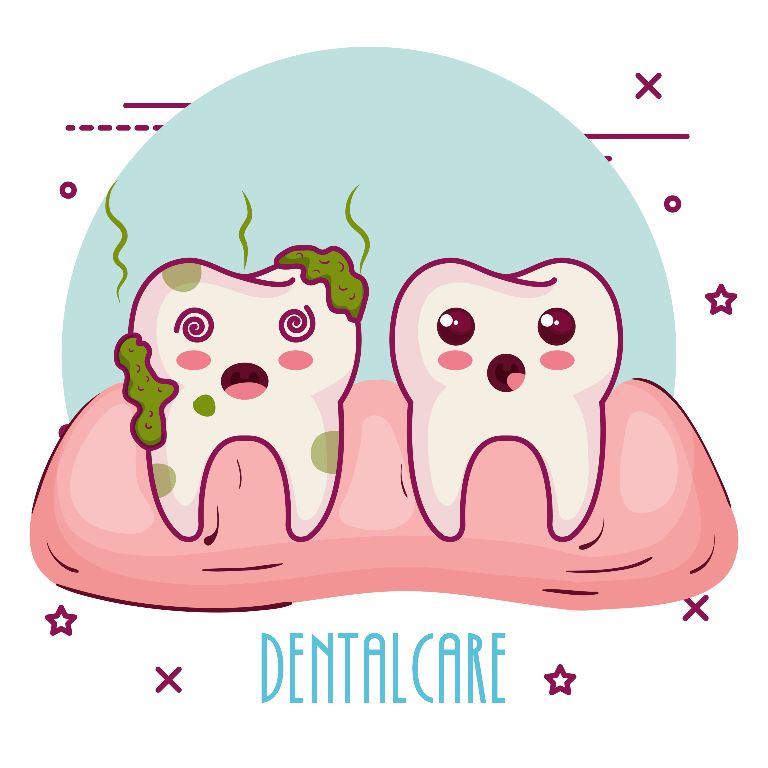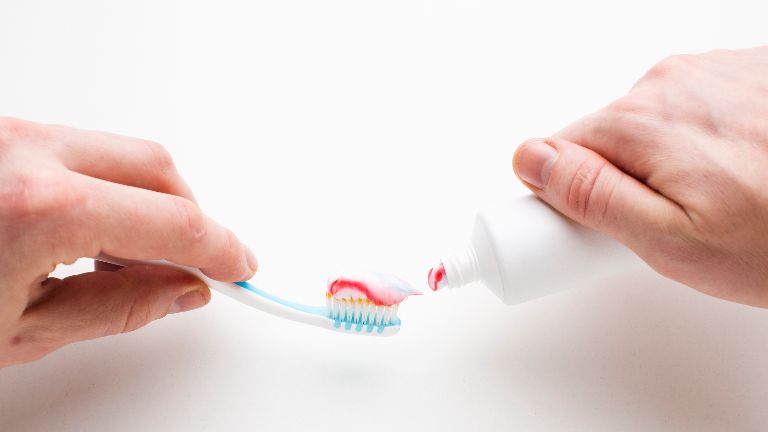We are sure that most of us are aware of the few most important basic daily habits that help us keep our teeth in good shape; brushing, flossing, and rinsing our mouths out with antiseptic mouthwash. These things help prevent the buildup of tartar on our teeth. But what is tartar? How does it end up on our teeth? And how does it affect the health of our teeth? That’s what we’re going to take a look at in this article, plus several extra useful ways to keep our teeth tartar-free.
Taking good care of our teeth at home will keep our teeth generally healthy, but it’s not enough to completely protect our teeth from bacteria. Dental plaque is a sticky film which is formed through bacteria mixing with food proteins. It forms on our teeth and pushes its way under our gums, carrying bacteria which damages tooth enamel leading to the development of cavities. Getting plaque removed regularly can help you avoid gum disease and tooth decay.
If you leave dental plaque on your teeth for too long without cleaning it off then it can harden into tartar. Tartar is porous and rough, and is also known as calculus. It forms both above and below the gum line and often results in gum disease and receding gums. To get rid of tartar, you need to visit the dentist so they can remove it with specialized tools for the job.
The buildup of tartar can hinder you from properly flossing and brushing your teeth which, in turn, makes your teeth more susceptible to tooth decay and cavities.
It can be dangerous if tarter forms above the gum line, since the bacteria in tartar damages and irritates the gums. Progressive gum disease can result if not dealt with in time. Gingivitis is the mildest type of gum disease and is generally stoppable with regular flossing, brushing, using antiseptic mouthwash, and visiting your dentist for regular cleanings.
If not taken care of, periodontitis can form, which is the forming of infected pockets between the teeth and gums. Chemicals get sent out by the immune system to fight this conditions, but these chemicals can get mixed together with the bacteria and other elements and end up causing damage to the tissue and bones holding the teeth steady.
All in all, tartar develops from a lack of proper maintenance on your teeth, and can be hard to get rid of on your own.

The neglect of oral hygiene is something that is unfortunately very widespread, and carries heavy consequences. The majority of dental issues stem from a lack of proper oral health, making it imperative to brush, floss and use antiseptic mouth wash on a daily basis. You’ll be able to avoid the buildup of plaque and tartar much easier if you follow these simple guidelines.
Once you have a serious accumulation of plaque or tartar, there aren’t many ways that you can get rid of it. There’s generally just one standard treatment for the majority of cases, and that is debridement. Debridement is the process where a dental specialist thoroughly cleans your teeth. A number of procedures are likely to be performed by your dentist if you’re going to get tartar removed. Depending on how far the damage has gone, you’ll need to undergo more or less of these.
One procedure is called scaling, where your dentist uses specially designed tools to scrape the tartar and dental plaque off the tooth enamel, both above and below the gumline.
In another procedure, called root planning, your dental specialist removes the corrosive acidic compounds that the oral bacteria creates. This is done to avoid tooth decay and any further tartar buildup.
Finally, you have tooth polishing, where the dentist scrapes soft plaque deposits and superficial stains off the tooth enamel. This is a routine procedure done by dental professionals and is completely painless. Tooth polishing isn’t only good for dental hygiene, but it carries an aesthetic value as well, leaving your teeth glossy, white and smooth.
These procedures will be necessary once you’ve accumulated a buildup of tartar, and you’ll need to do them at a dental professional. Catching it early is key to avoiding more serious issues and keeping your teeth healthy. If you notice your teeth turning yellow, you’ll want to visit your dentist right away to get your teeth cleaned.
Although there aren’t really ways to remove tartar at home, there are definitely ways you can avoid the accumulation of dental plaque which leads to tartar. Besides a regular tooth brushing, flossing, and mouth rinsing with antiseptic mouthwash, you can also rinse your mouth out with water after each meal to wash out any bits of food that may be lodged in the nooks and crannies between your teeth. Rinsing also trigger the salivary glands to work, which contributes to cleaning food particles out of your mouth.
You can also purchase specific tartar control toothpaste which will fight the buildup of plaque. These are commercially available and can be found all over the place. Toothpaste should generally contain fluoride, one of the most effective protective agents for your teeth out there. Also be sure to brush or scrape your tongue with your toothbrush when brushing your teeth, as cleaning your tongue off will ensure that there are no leftover food particles in your mouth that could trigger plaque buildup.
Plaque scrapers are what dentists use in dental scaling to remove plaque and tartar from the tooth enamel. Their sharp cutting edges are used to scrape the tooth down. Dentists will generally go underneath the gumline as well to clean all reachable parts of your teeth.
Although plaque and tartar definitely do need to be removed to keep your teeth healthy, it should not be done at home by any means. Visit a dentist to get them to clean your teeth for you and do not try and clean your own teeth with a plaque cleaner at home. Although you may be able to find them for sale in shops, it doesn’t mean you should use them on your own. Dentists study long and hard, with hours of practice to be able to use plaque scrapers properly, efficiently and without
harming the patient. Using them on your own can easily result in serious wounds, due to the sharpness of the tool. This will not only hurt, but can cause gum recession. Gum recession means that the sensitive roots of your teeth will be exposed and open up your gums to serious damage. It’s easy to cause damage to your tongue, cheeks, and other soft tissue with a plaque scraper. So it’s better to simply leave this job to the professionals and not try and use a plaque scraper at home.

On top of basic oral hygiene, there are a few more techniques you can try at home to prevent the buildup of plaque on your teeth.
One very old technique that’s been used for ages is oil pulling. You rinse out you’re your mouth using a tablespoon of extra-virgin coconut oil. Coconut oil is an anti-inflammatory agent, inhibiting oral pathogens from growing. Swish it around for a good long while, 15 minutes at the very least. Let the oil soak your teeth and gums before you spit it back out. Make sure you don’t gargle or swallow the oil, as it’s not good for your throat or stomach. This should be done before your morning tooth-brushing routine.
Massaging the gums with coconut oil, or warm sesame oil, every day is also a beneficial tactic for tooth and gum health. There are absolutely no negative side effects to this technique.
Another useful technique is brushing with baking soda. Baking soda exfoliates the teeth, scrubbing stains off your teeth. This works well as a natural teeth-whitener. Improvements from baking soda brushing won’t be life-changing, but they should be noticeable enough to make a difference.
Aloe vera is another natural remedy you can use on your teeth. Its antimicrobial properties don’t just fight plaque and gingivitis, but also work to rid your mouth of bad breath. Use the pulpy flesh that’s found in an aloe vera leaf and rub it on your teeth for several minutes (10 minutes should be sufficient). Try doing this twice a day for maximum results.
Rinsing your mouth out with cooled down green tea is also a technique that can help keep your teeth clean. Green tea is full of polyphenols and catechins which inhibit the corrosive activity of bacteria on your mouth. Not only this, but it’s also got a strong fluoride content which is one of the most powerful dental protective agents out there. Brew a strong cup of green tea and let it cool down. Once it gets to room temperature, rinse your mouth out with it. Swish a couple of times, and that should be enough.
All these tips, coupled with your regular brushing, flossing, and antiseptic mouthwash, will help keep your teeth safe from tartar building up on your teeth.

